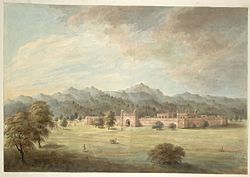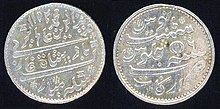Alamgir II
| Alamgir II | ||||||||||||||||||
|---|---|---|---|---|---|---|---|---|---|---|---|---|---|---|---|---|---|---|
Najib-ud-Daulah (1756–1759) | ||||||||||||||||||
| Born | Mirza Aziz-ud-Din 6 June 1699 Burhanpur, Mughal Empire | |||||||||||||||||
| Died | 29 November 1759 (aged 60) Kotla Fateh Shah, Mughal Empire | |||||||||||||||||
| Burial | , India | |||||||||||||||||
| Spouses |
| |||||||||||||||||
| Issue |
| |||||||||||||||||
Mirza Aziz-ud-Din Muhammad (June 6, 1699 – November 29, 1759), better known by his regnal name Alamgir II, was the fifteenth Mughal emperor from 1754 to 1759. He was the son of Jahandar Shah. Born Mirza Aziz-ud-Din, the second son of Imad-ul-Mulk after he deposed Ahmad Shah Bahadur in 1754. On ascending the throne, he took the title of Alamgir and tried to follow the approach of Aurangzeb (Alamgir I). At the time of his accession to the throne he was 55 years old. He had no experience of administration and warfare as he had spent most of his life in jail. He was a weak ruler, with all powers vested in the hand of his vizier, Imad-ul-Mulk.
In 1756, Mathura. While the Marathas became more powerful because of their collaboration with Imad-ul-Mulk, and dominated the whole of northern India. This was the peak of the Maratha expansion, which caused great trouble for the Mughal Empire, already weak with no strong ruler. Relations between Alamgir II and his usurping vizier, Imad-ul-Mulk had now deteriorated, their troubled relation would culminate in the murder of Alamgir by Imad-ul-Mulk. Alamgir II's son Ali Gauhar escaped persecution from Delhi, while Shah Jahan III was placed on the throne.
Early lifeAlamgir II was born Aziz-ud-Din on 6 June 1699 at Burhanpur and was the second son of Muizz-ud-Din, the son of future Emperor Bahadur Shah (Shah Alam). His mother was a jat, Anup Bai, with little clarity about her existence.[4] Aziz-ud-Din was 7 when his great-grandfather Aurangzeb died in the Deccan. After the death of his grandfather, Mughal Emperor, Farrukhsiyar .
Aziz-ud-Din was then imprisoned in 1714 and released in 1754, by the usurping Vizier Imad-ul-Mulk, he perceived Aziz-ud-Din as a frail personality who would not object his regime. Therefore, on 2 June 1754, Aziz-ud-Din was given the title Alamgir II by the vizier out of his own recommendation, as he wanted to follow the centralised approach of Aurangzeb. Succession to throneImad-ul-Mulk , a persecutor of the Mughal imperial family, holds a banquet.Imad-ul-Mulk hired Maratha mercenaries to do his bidding[5] and put all the imperial revenues into his own pocket and starved Alamgir II's family. He also persecuted Ali Gauhar , the elder son of Alamgir II.
Since then, relations between Alamgir II and Imad-ul-Mulk's regime were so bad that the latter got him assassinated in November 1759. ReignAfter the emergence of Alamgir II the Mir Bakhshi continued to be Mirza Ashraf, the son of Khan Dowran VII(a noble in the reign of Farrukhsiyar and Muhammad Shah).[6][7]
Alliance with the Durrani EmirateIn the year 1755, the acclaimed Sikh rebels in the eastern regions.
Ahmad Shah Durrani and his forces then marched into Punjab .
 He then marched towards Delhi, in January 1757, the Mughal Emperor Alamgir II with courtiers such as Shah Waliullah, nobles such as Marathas in combat and threatened to overthrow and execute the regime of Imad-ul-Mulk.
Ahmad Shah Durrani's relations with the Mughal Emperor, strengthened further when his son Timur Shah Durrani was chosen as the suitor of Alamgir II's daughter Zuhra Begum. Ahmad Shah Durrani himself also married Hadrat Begum the daughter of the former Mughal Emperor Muhammad Shah.[8]
Ahmad Shah Durrani returned to Kabul leaving his forces led by his son Timur Shah Durrani consolidating themselves inside the garrisons of Lahore where they founded the Zamzama cannon with the assistance of Mughal Metalsmiths. He was supported by Muhammad Nasir Khan I (Khanate of Kalat).[9]
Siege of Delhi (1757)In July 1757, the Marathas led by Jamuna they began to besiege Delhi.
The Marathas fought against Alamgir II's incumbent Unable to gain any assistance from Ahmad Shah Durrani, who was engaged in quelling various rebellions near Herat; Najib-ul-Daula surrendered after resisting the combined brigands of Maratha Confederacy for more than five months, he conceded defeat and withdrew to Najibabad. When the Marathas entered Delhi the emperor Alamgir II and his royal family had somehow fled to Bharatpur State. The Marathas looted and plundered the city and the people of Delhi. Mosques and Shrines built by the Mughals were desecrated; and the Peshwa conspired to place Vishwasrao upon the Mughal throne. Imad-ul-Mulk was reappointed Mir Bakhshi and with the support of the Marathas. However, despite losing control of Delhi, Najib-ul-Daula and his associates, such as Qutub Khan and Abdus Samad Khan the Sirhind, continued to challenge the Maratha Confederacy and its allies during confrontations at Saharanpur and Shahabad Markanda. In response the Marathas sacked the inhabitants of Taraori, Karnal and Kunjpura.[10]
The Maratha attack upon Kunjpura triggered a military response by Ahmad Shah Durrani. Whose forces crossed the sacred rivers of India in search of their Maratha opponents. Subjects opposing the Maratha ConfederacyIn the year 1756, Alamgir II sympathised with the cause of his loyal Maratha chieftain Balaji Baji Rao .
Third Carnatic War (1757–1763)Carnatic Wars .Loss of BengalAlamgir II grieved the death of Imad-ul-Mulk against the imperial family.
Authority in the DeccanThroughout Alamgir II's reign French commandant Nizam Ali Khan .
Nawab of BhopalIn the year 1758, the Nawab of Bhopal the only chosen administrator of Raisen, the emperor also granted the title Bahadur to Faiz Mohammad Khan the Nawab of Bhopal. However the fort remained under the control of Mamola Bai and the renegade Nanasaheb Peshwa. The fortress of Raisen was quickly retaken by Faiz Mohammad Khan in the year 1760, after the tragic assassination of Alamgir II and after Sadashivrao Bhau threatened to ravage Bhopal prior to the Third Battle of Panipat . It is believed that Faiz Mohammad Khan's Sepoy's were among those who had cut off the various supply routes of the Marathas just before the Third Battle of Panipat.
Nawab of CambayNajm-ad-Dawla supported British presence in Cambay . Turning much of his estate into an international "safe zone". Although it is likely that he too had to face threats from the Maratha climax.
"Nawab of Mysore"In Maratha Confederacy ".
In honour of his achievements during the Carnatic Wars , the king gave him the title "Nawab Haider Ali Khan Bahadur".
Zenith of the Maratha ConfederacyMaratha Confederacy at its zenith in 1760, the Peshwa discussed abolishing the Mughal Empire and placing Vishwasrao on the imperial throne in Delhi .In 1758 the Marathas. This victory made the belligerent Peshwa, grandiosely sack Delhi, and stated his intentions of placing Vishwasrao on the Mughal throne.[12]
AssassinationMany of his actions had angered the people of India. Fearing a backlash in the summer of the year 1759 Prince Ali Gauhar escaped from Delhi. Agitated by the daring escape Imad-ul-Mulk and Sadashivrao Bhau reckoned that Alamgir II was about to advance his son Prince Ali Gauhar, to dispossess and overthrow their regime.
After detailed consideration Imad-ul-Mulk and an angry mob of various ethnic groups plotted to murder the Mughal Emperor Alamgir II and the assassinations of prominent members of his family in the winter of 1759.[13] AftermathThe defeat of Alamgir II's son-in-law, These developments eventually culminated into rise of religious and political loyalties that eventually clashed at the "Third Battle of Panipat" in the year 1761.Foreign relationsSeven Years' War In 1756, the Seven Years' War had broken out and Alamgir II was supported by various international belligerents of that war. It was the first global war in which the Mughal emperor had his involvement apart from the boundaries of India. Alamgir II was initially involved in that war because the British were hasty in their attempts to conquer Bengal Subah.  In 1755, De Bussy received letter from new Carnatic Wars in favour of the French East India Company.[16]
In 1757, Alamgir II had successfully achieved peace between the Mughal Emperor Muhammad Shah in 1757.[18]
in the year 1751, the Nawab of Junagadh .
It is believed that Alamgir II even tried to reconcile the English East India Company and the French East India Company before his death in 1759.
Death The newly appointed Mughal Maratha leader Sadashivrao Bhau and launched an counterattack against Najib-ud-Daula which lasted 15 days and resulted in the defeat of Najib-ud-Daula who was driven north.
Muslim populace.
In popular culture
See alsoReferences
External linksWikimedia Commons has media related to Alamgir II. | ||||||||||||||||||


